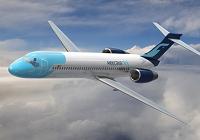Mexicana's vision for profitability and an initial public offering have dramatically vaporised as intense competition, unfavourable labour rates and its own rapid growth have sent the carrier into creditor protection.
Admitting its losses had reached a point where the carrier was "financially unviable" Mexicana filed for bankruptcy protection in Mexican and US courts in early August. The carrier placed most of the blame for its woes on high mainline labour costs.
But the global economic downturn and H1N1 were clearly the big unknowns in its ambitious business plan, which was initiated after Grupo Posadas acquired the carrier from government holding company Cintra in 2005 and envisioned profits from 2009. Instead Mexicana's mainline unit posted a 2.2 billion peso ($173 million) loss in 2009 and a 1.8 billion peso loss for the first six months of 2010, according to bankruptcy court documents.
 |
|---|
Mexicana's weak results sharply contrast with rival Aero-mexico, which claims it returned to the black in the first half of this year. But while Aeromexico last year initiated a restructuring that entailed capacity, fleet and job cuts, Mexicana added capacity in 2009 and introduced three new fleet types - Airbus A330s at mainline, Boeing 717s at Click and CRJ200s at Link. The A330s along with two additional Boeing 767s were used to launch Mexicana's first transatlantic services, while the CRJ200s were acquired to launch Guadalajara-based Link. Grupo Mexicana also invested heavily in new IT to support the carrier's ascension into oneworld, which was completed last November.
Expensive Expansion
Mexicana was banking on the expansion, which resulted in the carrier taking on Aeromexico in several new markets, backing its drive to become the country's leading carrier and potentially putting it in a position where it could even acquire Aeromexico. But the timing couldn't have been worse as the brutal combination of the global economic downturn and the H1N1 virus led to stiff losses at a time when the carrier needed to start turning a profit. Mexicana now admits "time is of the essence" as it seeks a $100-$150 million cash infusion and attempts to use courts in Mexico and the USA to prevent lessors from seizing its aircraft.
If Mexicana fails to successfully restructure its mainline business, 9.5% of Mexico's domestic market needs to be absorbed by other carriers or disappear. Aeromexico and the country's three surviving low-cost carriers - Interjet, Volaris and VivaAerobus - would be the obvious benefactors as they were already planning fleet expansions. Click or Link, which combined now have a 19% share of the market, could also potentially expand to fill the void. But it is unclear if they could survive without Mexicana, which insists it has no plans to kill the mainline entity while retaining its two-lower cost units.
Mexicana mainline also has 18% of the Mexican international market, which is controlled by foreign carriers with a combined 72% share. Aeromexico, which only has a 7% share based on passengers carried, again stands to benefit and low-cost carriers could also take advantage. But on US routes, accounting for most of Mexicana's international traffic, US carriers could benefit at least initially because Mexican carriers are currently unable to add services to the US due to the FAA's July decision to downgrade Mexico to category 2 under its safety assessment programme.
Click here for more on how the Mexican market has developed this year
Source: Airline Business
















